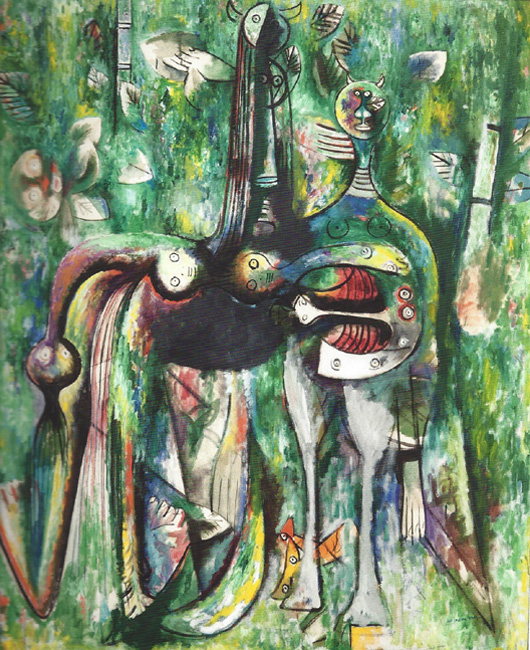Source: WTL photo© Wilfredo Lam exhibition in 2016 at the Museo Nacional Centro de Arte Reina Sofía in Madrid.
Image: "Le Sombre Malembo, Dieu du carrefour [The Sombre Malembo, God of the Crossroads]" (1943). Oil on canvas. Rudman Collection. Although Lam identifies Malembo as a god of crossroads, also, in the Yoruba religion, malembo leaves are sorcerers' messengers that possess a person's spirit while they are sleeping.
Comments: In 1940, due to the Nazi occupation of Paris, Lam, along with thousands of Parisians went south. In Marseille Lam worked closely with Surrealists, most prominent among whom was André Breton. The following year he returns to Cuba. Note what Elizabeth T. Goizueta says about Lam's identity conflict (Europe vs. Cuba/New World) when he returned to Cuba in 1941: "Paradoxically, the more Carpentier and other Latin American writers tried to separate themselves from Europe, the more dependent they became on a European mode of expression to claim their new consciousness. Specifically, these visionaries turned to the baroque style, rich in hybridization, adopting and reconfiguring it to fit the new Latin American artistic vision. Hybridization was the key to Lam's nascent signature iconography of the forties: it provided the bridge between surrealism and magical realism." Wilfredo Lam; Imagining New Worlds. Ed. Elizabeth T. Goizueta. Boston: McMullen Museum of Art, Boston College, 2014, p. 4. In addition, it should be noted that in Cuba Lam joined the intellectual/artistic community there where he and they sought to construct an approach to the way in which Cuban culture diverged independently from European models. Among these Cuban intellectuals were Fernando Ortiz, Lydia Cabrera, Virgilio Piñera, José Lezama Lima, and Aimé Fernand David Césaire a Francophone and French poet, from Martinique, who was one of the founders of the French literary négritude movement. Among other promenent aspects of Lam's art in the 40's and beyond are "transculturation," "decolonization," "instability," "hybridity," "musicality," "orphism," "schematicism," and the "dialectic of the mask."
Humanities Questions: (A) Apply Goizueta's statement above to this painting. If necessary, refer to Carpentier's essay: => "About the Latin American Real Maravilloso"; (B) Choose one or more of the terms listed at the end of the Comments section above and use it to analyze this particular painting.

